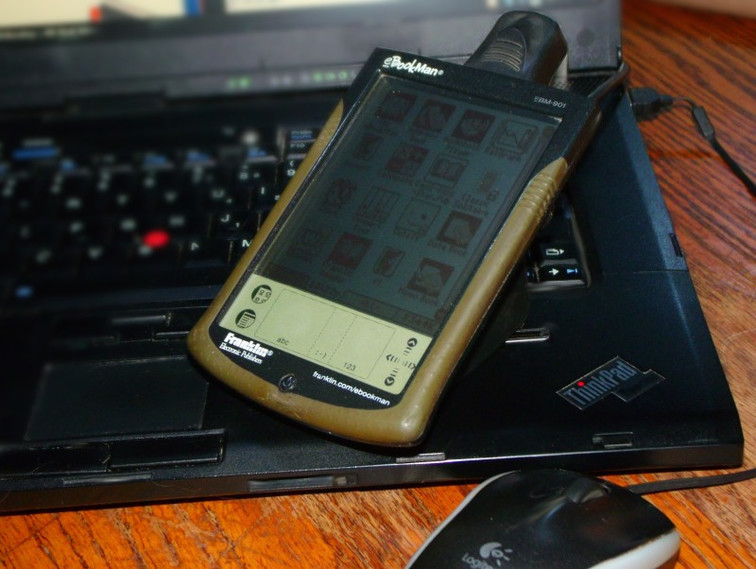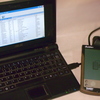
Franklin eBookMan EBM-901
Today, we have our smart phones and tablets and Kindles and iPads, and all these other modern day marvels that monitor us and govern our lives. But, you know, I still prefer my good ol’ Franklin eBookMan to handle all of my mobile computing needs. I can just hear you now… “what is a Franklin eBookMan?!” Simply put, it did what the iPods and iPads do, it just did it back in 1999. The Franklin eBookMan was an E-Book reader and personal PDA, produced from 1999 through to 2002, under the Franklin Electronic Publishers brand. Franklin then sold the rights of the eBookMan to American company ECTACO Inc., who continued to produce and support the EBM series handhelds through to 2011. Some of the features that set the eBookMan apart from the other PDAs out on the market at the time where: In the relatively short time that the eBookMan was in production, the online community of users and coders developed some really great software for this amazing handheld device. Not only was the eBookMan great for reading e-books and periodicals, but it was a very robust and entertaining PDA, thanks to the software talented developers produced. it was also very easy for independent publishers to produce high quality books and other reading material for the eBookMan. Franklin provide, free of charge, a detailed guide on how to create e-books using their own version of the SGML (Standard Generalize Markup Language) that they developed for the eBookMan, called FGML. They also freely distributed the Franklin SDK desktop application that took an FGML file and complied it into an e-book compatible with the Franklin Reader app. Books compiled for the eBookMan supported monochrome images, indexing, and very fast keyword search capabilities. I even ran a small on-line publishing company for a while, converting classic novels to eBookMan format. I also had a small handful of authors who use my services to publish their original works. According to my records, we distributed around 2,000 e-books to eager eBookMan customers. After all of these nineteen years, this PDA still works flawlessly. Sure, the rubber grip along the bottom edges of the “console” has discoloured over the years, but besides that, everything is functioning as it was when it was new. The touch screen is still responsive and the backlit screen still looks great. Back in the day, I had regular news feeds from The Register and ZDNet, which I converted to MobiPocket Reader format, so I could read them “on the go”. In the bottom quarter of the screen is where you write in the letters and numbers that you wish to enter into the program that you’re using. This area was know as the “silkscreen”. The first thing I did when I bought my eBookMan was cover the silkscreen with a protective membrane to help keep it from getting too scratched up from day to day. Looks like my idea paid off, as it’s this membrane this is showing some wear and not the screen beneath. The form factor is easy to hold in my hand and is very light. I find it much more comfortable as an e-book than a tablet or Kindle-style device. The back-lit screen is very easy on the eyes, so I can sit and read in a darkened room and not disturb my wife. We both find screens on tablets and other modern e-book readers to be too bright and harsh on our aging eyes. The best things I like about the eBookMan and why I still use it today over modern day alternatives are: When I bought my eBookMan, I also bought a 32MB MMC expansion card for it and a protective carrying case. Tucked away in side a pocket within the case, I still have my original receipt for the purchase. It is badly faded, but it still shows that the eBookMan was a pretty expensive piece of tech, back in the day. The receipts shows that I made my purchase on April 25th of 2002, and spent $199.99 on the eBookman, $59.99 for the 32MB MMC card, and $19.99 for the case. I think I got some very good value for my money! My wife also has an eBookMan; her’s is a model EBM-900. After all of these years the only thing that is broken on it is the little plastic clasp on the battery door. Apart from that, the eBookMan is working just as good as it did back in 2002. She likes reading books with it, too. In fact, just tonight I finished compiling a copy of “The Railway Children” for her from a text file we downloaded from Project Gutenberg. I’m so glad that I have my eBookMan today. This was such a fantastic PDA / e-book reader and I feel that it should not just be forgotten like so many other technologies from the earlier days of home computing. I know that Apple wants you to think that they are the super-innovator of the personal computer market. But, just look at the eBookMan and you tell me, who invented what first. The eBookMan was doing what the iPod did at least two years before, and it was doing what the iPhone did seven years before (apart from making telephone calls). |
|





